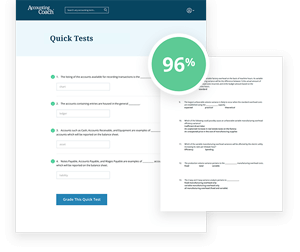1.
When a sale is made with the credit terms of 2/10, net 30, the "10" refers to the __________
discount period.
2.
On June 1, $800 of goods are sold with credit terms of 1/10, n/30. How much should the seller expect to receive if the buyer pays on June 8?
3.
On June 1, $800 of goods are sold with credit terms of 1/10, n/30. On June 3 the customer returned $100 of the goods. How much should the seller expect to receive if the buyer pays on June 8?
4.
With credit terms of 2/10, n/30, the annual interest rate for paying in 10 days instead of 30 days is closest to
5.
When the terms of a sale are FOB __________
destination, ownership of goods will transfer to the customer at the customer's dock.
6.
The seller is responsible for the costs of shipping its goods to the buyer when the terms of the sale are FOB
7.
The buyer is responsible for the costs of shipping when goods are sold with the terms FOB
8.
When the Allowance for Doubtful Accounts appears on a company's financial statements, its balance will be a __________ balance.
9.
On which financial statement would you expect to find Allowance for Doubtful Accounts?
10.
Which method of reporting losses on accounts receivable is required in the U.S. for income tax purposes?
11.
Which method of reporting losses on accounts receivable is to be used for financial reporting?
12.
The seller of goods that is offering credit terms of net 30 days will likely be one of its customer's __________ creditors until it receives payment.
13.
After several years of operations, a company's Bad Debts Expense for a given year is likely to be the same as its balance in Allowance for Doubtful Accounts.
14.
A company estimates that $20,000 of its $500,000 of accounts receivable will be uncollectible. Its Allowance for Doubtful Accounts presently has a credit balance of $8,000. The adjusting entry will include a __________ to the Allowance for Doubtful Accounts.
15.
A company estimates that $20,000 of its $500,000 of accounts receivable will be uncollectible. Its Allowance for Doubtful Accounts presently has a credit balance of $18,000. The adjusting entry will include a __________ to Bad Debts Expense.
16.
A company estimates that $20,000 of its $500,000 of accounts receivable will be uncollectible. Its Allowance for Doubtful Accounts presently has a debit balance of $3,000. The adjusting entry will include a __________ to Allowance for Doubtful Accounts.
Use the following information for questions 17-21:
A company is expecting thousands of credit sales transactions each week with terms of net 30 days. The company uses the allowance method and it prepares weekly financial statements. It believes that 0.001 of its credit sales will be uncollectible. The company's credit sales for its first week of operations are $500,000. The credit sales for its second week are $600,000.
17.
The company's bad debts expense for its first week of operations will be $__________
$500
$500,000 times 0.001.
18.
The balance in Allowance for Doubtful Accounts at the end of the first week will likely be $__________
$500 .
19.
The company's bad debts expense for its second week of operations will be $__________
$600
$600,000 times 0.001.
20.
The amount of accounts receivable that you expect will be written off by the end of the company's second week of operations is $__________
$0
Since none of the accounts are due for several weeks, it is unlikely that an account will have been written off..
21.
The balance in Allowance for Doubtful Accounts at the end of the second week of operations will likely be $__________
$1,100
$500 + $600..
Use the following information for questions 22-25:
A company's Allowance for Doubtful Accounts has a credit balance of $25,000. It learns that one of its accounts receivable amounting to $1,800 is worthless and needs to be written off.
22.
Which account should be debited for $1,800 when writing off the account?
Allowance For Doubtful Accounts
23.
Which account should be credited for $1,800 when writing off the account?
Allowance For Doubtful Accounts
24.
Assuming that after the account is written off, the supplier receives full payment from the customer. Which account will not be involved in the accounting entries made at the time when the payment is received?
Allowance For Doubtful Accounts
25.
Under the direct write off method, which account is debited when a company writes off one of its accounts receivable?
Allowance For Doubtful Accounts
26.
Sorting a company's accounts receivable into classifications such as current, 1-30 days past due, and 31-60 days past due is known as the __________
aging of accounts receivables.
27.
The receivable turnover ratio is computed by dividing the net credit __________
sales for the year by the average amount of accounts receivable during the year.
28.
The days' sales in accounts receivable is calculated by dividing __________
360 or 365 days by the receivables turnover ratio during the year.
29.
A company's accounts receivable minus its allowance for doubtful accounts equals the net __________
realizable value of the accounts receivable.
30.
In some industries, companies often sell their accounts receivable to a firm known as a __________
factor.


